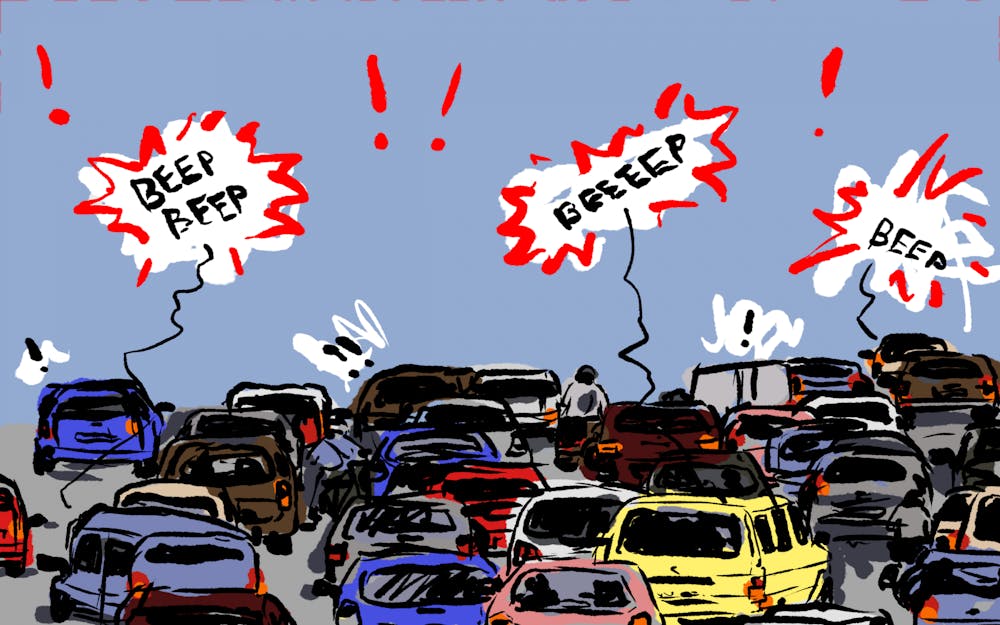The world is now built for cars.
You can see it across the country — what were once condensed cities have ballooned into exponentially larger expanses of suburbs and strip malls. Acres of land are transformed into hostile gray parking lots, all for the unrelenting dominance of the automobile.
Admittedly, cars are extremely convenient. They allow us to travel efficiently and on our own time. However, our dependence on cars is a devastating trend. In the pursuit of the perfect world for the car, we have made an imperfect one for ourselves.
Large roads are detrimental to the planet. Roads and large numbers of cars pollute the environment and harm animals who live nearby. Along with this, noise and light pollution negatively impact humans and wildlife alike.
[Related: Minority group advocates express concerns about new electric car charging stations in Indiana]
Furthermore, cars are physically dangerous to the people who operate them. In 2020, there were 13.2 vehicle deaths per 100,000 people in Indiana.
Sure, it’s a passé platitude; we’ve all seen the horrific crash videos that they show us in driver’s ed. But it’s seriously odd that everyone is expected to accept that the vehicle we drive daily can cause our untimely demise at any moment.
Surely the solution to this is simply to encourage public transportation usage. But that’s if you even have access to it.
45% of Americans have no access to transit. Anecdotally, growing up in a rural area displayed this lack of public transportation to me. Going into town? Drive. Hanging out at the mall? Drive. Buying groceries? Drive, drive, drive.
Formerly, more people commuted to work using publicly available transportation. In 1970, 9 percent of workers commuted. In 2021, it was just 5 percent.
The growth of the American suburb has pushed more people into the outskirts of the city and away from what transportation is left. More people now drive to work. This creates a greater need for large roads to facilitate these drivers.
Where these roads are placed is not an exact science. Their construction is advanced by humans, who are subject to the same biases that all humans face. And this means that roads can be used as a political tool to harm marginalized communities.
Historically, roads have been used to create racial boundaries. As the interstate highway system grew in the 1950s, highways were often strategically built to crush communities of color. We can even see this here in Indiana, where residents of Indianapolis’s historically Black Indiana Avenue were pushed out by the construction of I-65 and I-70.
[Related: Meet the candidates for the 2023 Bloomington mayoral election]
Along with this, car-centric areas are just ugly. Walking down to the College Mall in Bloomington one day, I was struck with how much natural beauty faded as I left campus. I was suddenly surrounded by antagonistic, dull asphalt and multitudes of cars screaming past me at 40 miles per hour. It seemed like the whole area was built to encourage me to leave as soon as possible.
How can we solve these issues? Simple: focus on the people.
Emphasizing the pedestrian over the car allows for a better city environment for everyone. Cities and towns across the globe, including Bloomington, have started implementing pedestrian-only streets to great success. Introducing more pedestrian-focused spaces increases economic wealth, happiness and access to transportation.
As author Edward Abbey says somewhat sarcastically in his book “The Monkey Wrench Gang,” “The engineer’s dream is a model of perfect sphericity, the planet Earth with all irregularities removed, highways merely painted on a surface smooth as glass.” If steps against our car-dominant society aren’t taken soon, “just one more lane” will soon turn into a fully paved world, just as Abbey states.
Danny William (they/them) is a freshman studying media. They admit their bias in this article with the confession that they really, really dislike driving.






